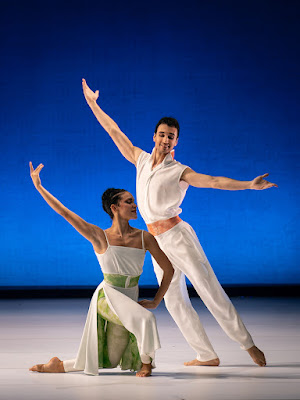In dance, I have often considered exercises to be repeated actions done in relative repetition to both warm up the body, as well as build good physiological habits. It is one thing to know how we would like our bodies to move, and another matter altogether as we try to enact that which we imagine!
When I was learning to kayak, I thought that everything was happening too fast, as I was sitting in a tiny boat on a moving surface. Yet repetition of the most basic strokes (starting with forwards, backwards, and turning) seemed to allow time to expand, and eventually what seemed to require rapid-fire reflexes settled into a slow motion action sequence.
 |
| 1990-ish my first dugout canoe paddle on Lake Bratan, Bali, Indonesia. |
For teaching modern classes versus ballet classes, my emphasis is in training the use of the torso and knowing how to find and fall away from our center of balance (and gravity), focusing on more grounded shifts of weight and how to shape space through movement, with less emphasis on the balletic footwork and ports de bras (carriage of the arms).
Classroom exercises progress to enchaînement (sequences of varying movements strung together) in ballet where each individual step learned is linked in complex phrases. Mostly, I have found that what makes ballet enchaînement feel more advanced is actually the rhythm that shapes the steps we learned in exercises. A rond de jambe in an even 4/4 can feel very different than one in more clipped 2/4 march-like rhythm, or even a 3/4 waltz.
Below are two clips of dance by Paul Taylor where variants of rond de jambe are an integral component of the choreography.
I can't tell you what in life will make you happy in your own body, happy with how you move through life, happy with the choices you make. I can tell you that by finding connections between everything I do and learn in life only adds to my sense of fulfillment in this experience. Almost everything I consider to be within my expertise and knowledge has come through a process of being a beginner making mistakes, stumbling, and learning from both missteps and surprising gifts of coordination.
And while the LEARNING has always been up to me to apply myself and be open to change, I would have no way of understanding what I was learning except for the people who have shared their history and experience with me. A book, a website, an instructional video, have never been enough for me to truly learn something, especially if I want to feel it in my body. And I never encountered a teacher from whom I didn't have something to learn.
After more than four decades in the dance field around the world, I think I have a few valid perspectives to offer. And I am grateful to students and dancers who have kept in touch and offered kind sentiments about learning from me.
I hope you will join me in class one day at the Taylor School of Paul Taylor Dance Company in NYC. It is a city filled with amazing teachers with an untold wealth of life experience and knowledge. Hopefully the addition of four new dance studios will bring more of you to find out what Paul Taylor's legacy continues to offer the future of artistic wellbeing and exceptional dance.





















